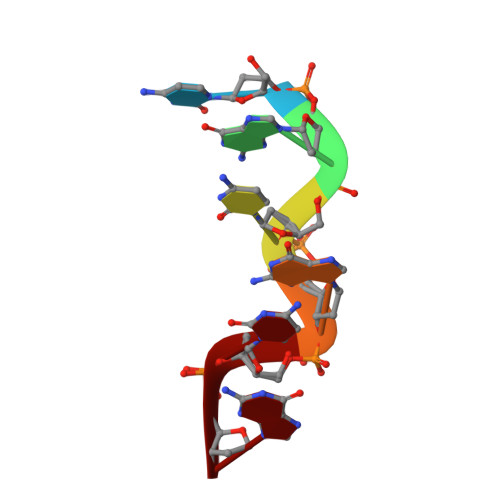Crystal structure of Z-DNA in complex with the polyamine putrescine and potassium cations at ultra-high resolution.
Drozdzal, P., Gilski, M., Jaskolski, M.(2021) Acta Crystallogr B Struct Sci Cryst Eng Mater 77: 331-338
- PubMed: 34096514
- DOI: https://doi.org/10.1107/S2052520621002663
- Primary Citation of Related Structures:
7ATG - PubMed Abstract:
The X-ray crystal structure of the d(CGCGCG) 2 /putrescine(2+)/K + complex has been determined at 0.60 Å resolution. Stereochemical restraints were used only for the putrescinium dication, and 23 bonds and 18 angles of the Z-DNA nucleotides with dual conformation. The N atoms of the putrescine(2+) dication form three direct hydrogen bonds with the N7_G atoms of three different Z-DNA molecules, plus three water-mediated hydrogen bonds with cytosine, guanine and phosphate acceptors. A unique potassium cation was also unambiguously identified in the structure, albeit at a ∼0.5 occupation site shared with a water molecule, providing the first example of such a complex with Z-DNA. The K + cation has coordination number of eight and an irregular coordination sphere, formed by four water molecules and four O atoms from two phosphate groups of the Z-DNA, including ligands present at fractional occupancy. The structural disorder of the Z-DNA duplex is manifested by the presence of alternate conformations along the DNA backbone. Comparison of the position and interactions of putrescine(2+) in the present structure with other ultra-high-resolution structures of Z-DNA in complexes with Mn 2+ and Zn 2+ ions shows that the dicationic putrescinium moiety can effectively substitute these metal ions for stabilization of Z-type DNA duplexes. Furthermore, this comparison also suggests that the spermine(4+) tetracation has a higher affinity for Z-DNA than K + .
- Center for Biocrystallographic Research, Institute of Bioorganic Chemistry, Polish Academy of Sciences, Poznan, Poland.
Organizational Affiliation:


















